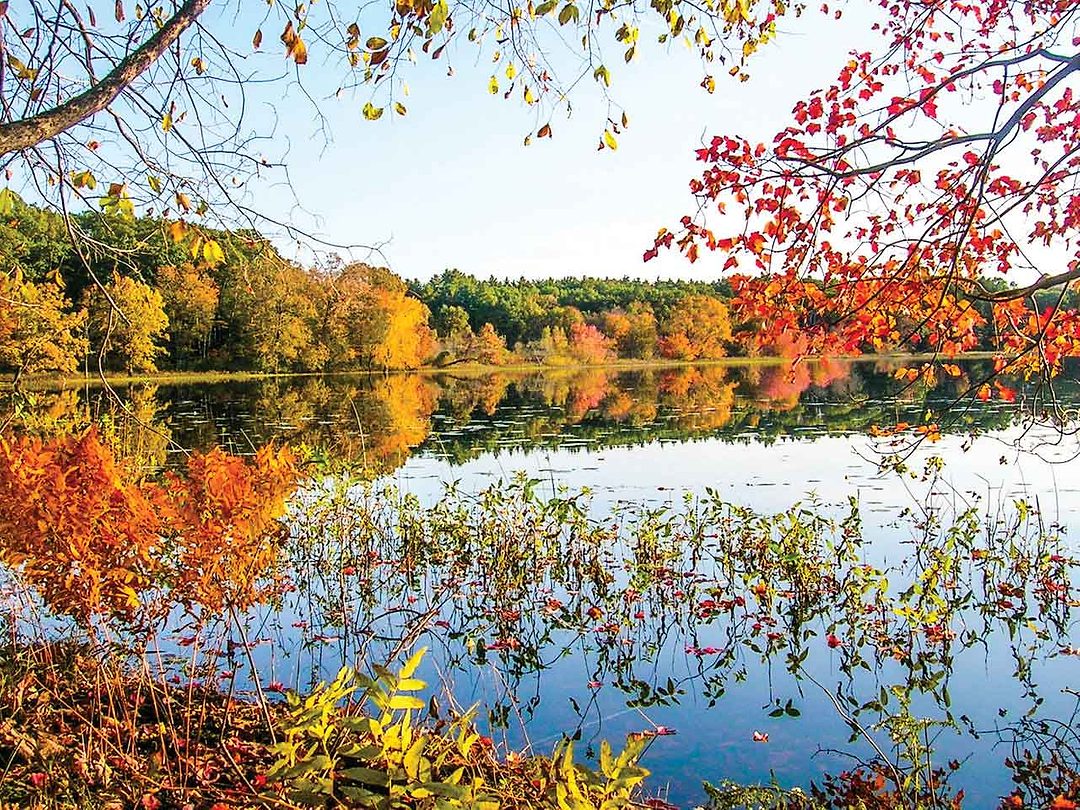Photography by Dave Witherbee
Whether you love to hike, fish, canoe, birdwatch, or even camp, Fairhaven Bay is the perfect destination for an Autumn outing.
Fairhaven Bay started as a kettle hole like Walden Pond when a large chunk of heavy glacial ice sank and melted. In the case of Fairhaven Bay, the Sudbury River broke through and the silt from the river filled in, creating a shallow bay. The fish like it and so do the fishermen! The Bay has bass, pickerel, carp, sunfish, and pike. Because the Bay is shallow it freezes early, allowing the ice fisherman to drag their sleds out on the Bay in the winter months. You’ll see ice skaters and cross-country skiers enjoying the ice as well.
Fairhaven Bay boasts some of the area’s most beautiful walking trails, many with stunning overlooks. Visit the Wright Woods Concord Land Conservation Trust for walking maps.
To enjoy the Bay from the water, rent a canoe or kayak at the South Bridge Boat House in Concord and enjoy a leisurely paddle about 2.5 miles to the Bay.
However you get there, be sure to watch for the wide array of wildlife that enjoy Fairhaven Bay as well.

Great Egret Few birds are as stately as the Great Egret. You’ll find this graceful creature delicately stepping through the marshy ground near the edge of the Bay seeking its favorite meal of fish, frogs, snakes, and other aquatic insects. The Great Egret is the symbol of the National Audubon Society.

Pileated Woodpecker It’s hard to miss that flash of red crest and the loud drumming as a Pileated Woodpecker looks for food. This is the largest woodpecker in North America except for the Ivory-bill which is thought to be extinct. That long beak makes it easy to excavate ants, termites, and other insects from rotting wood. They also enjoy fruits, berries, and nuts when they can find them. Listen for their call or the tap-tap as they drum for food.

White-tailed Buck White-tailed deer are common in Massachusetts and can live over 10 years in the wild. They are a common site near Fairhaven Bay, and they’re faster than you might think – running up to 40 mph for short bursts. Deer are herbivores and eat a wide range of plants, as any gardener will tell you.

Osprey You’ll see the Osprey flying close over the Bay as it looks for fish. When it spots a tasty fish, the Osprey will dive straight into the water, coming up with a fresh fish for dinner at least once out of every four dives. Ospreys live 15-20 years and may fly more than 160,000 migration miles during a lifetime. During 13 days in 2008, one Osprey flew 2,700 miles—from Martha’s Vineyard, Massachusetts, to French Guiana, South America!*

Red Squirrel This little guy looks as though he’s waiting for lunch. Conifer seeds are his favorite food, but he’ll happily eat nuts, grains, insect larvae, and even the inner bark of trees. Red squirrels are active during the day as long as it’s not too hot.

Mute Swan Fairhaven Bay is the perfect place for Mute Swans. These swans swim serenely on the surface of the Bay feeding mainly on plants, although they will sometimes eat tadpoles or small fish as well. You may see their large nests, about 5’ – 6’ in diameter, on the shoreline or in shallow water. Mute Swans are generally silent but they can make a kind of barking noise when they want to.

Smartweed Massachusetts is the only New England state in which Smartweed appears. This annual weed grows in wetlands and marshes and was used historically to stop bleeding. Ducks, small birds, and some mammals eat the seeds. Like many ‘weeds’ Smartweed can be a nuisance in the lawn or garden but serves a vital role in nature.

Buttonbush This small shrub is native to North America and loves wet soil. You’ll find it along the edges of the Bay where it grows happily in the marshy areas. In summer its white flowers look like pincushions and provide food for bees, butterflies, and other pollinators and its winter fruit attracts over 24 species of birds. Buttonbush is an excellent choice for home gardens if you have a wet area.

Green Heron Unlike the larger herons, you won’t find the Green Heron standing proudly in the shallows. Instead, this small, solitary heron prefers to hide in the vegetation near the edge of the water. The Green Heron loves to eat fish, frogs, and other aquatic animals and even uses ‘bait’ to catch them! The heron will sometimes place a small twig, insect, or feather on the surface of the water to lure the fish in striking range. It’s iridescent-green back can sometimes appear dull in low light.
Did you take a great photo of your favorite animal or plant on your walk? Email your best photo to us at cynthia@voyager-publishing.com and we will publish the top photos in our Winter issue. The winning photographers will each receive a one-year Audubon society membership or a subscription to Ranger Rick magazine.



